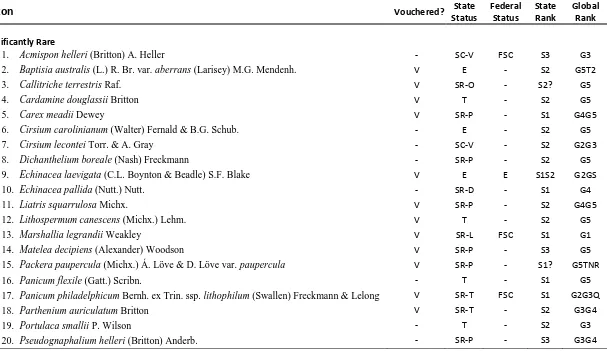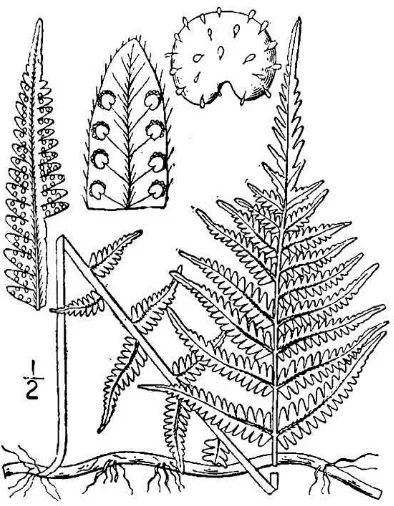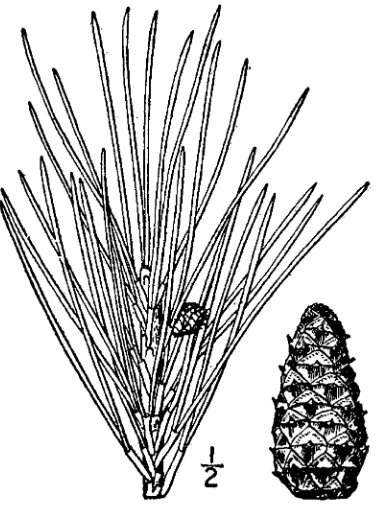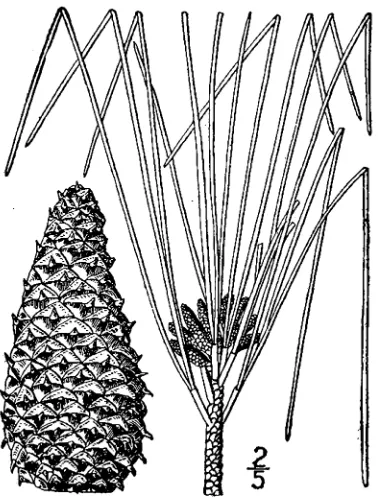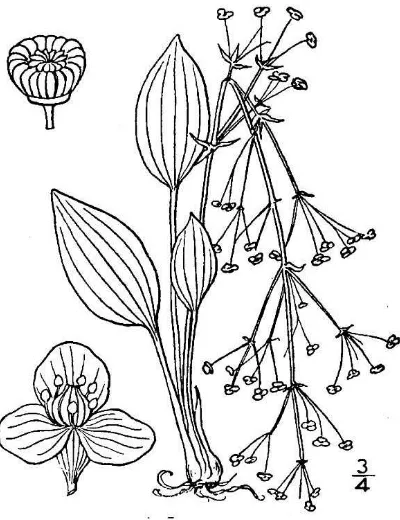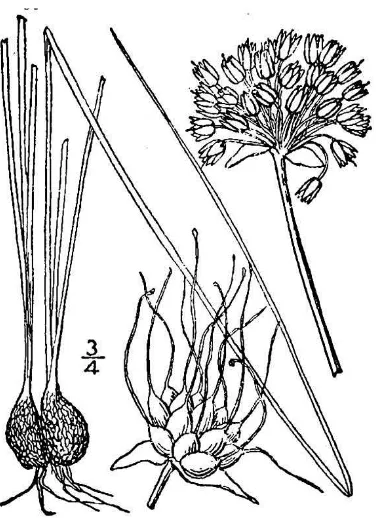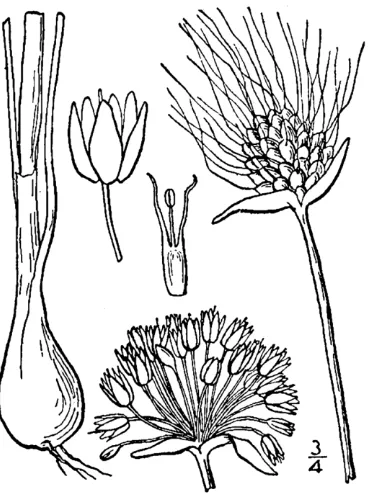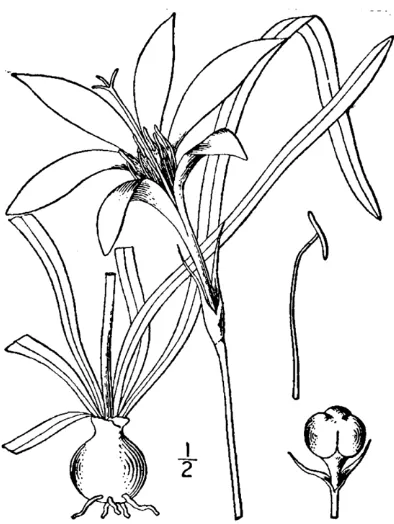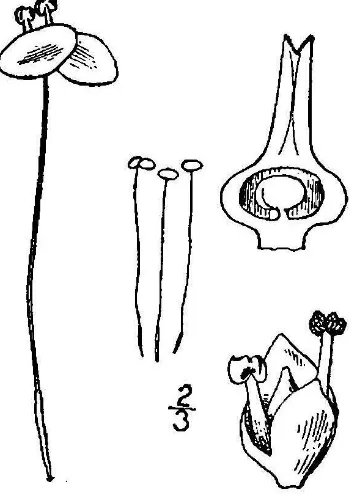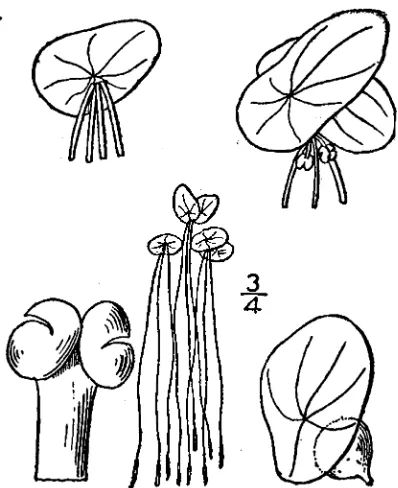ABSTRACT
STANLEY, JENNIFER SARAH. Guide to the Vascular Flora of Picture Creek Diabase Barrens (Granville County, North Carolina). (Under the direction of Alexander Krings).
Picture Creek Diabase Barrens (PCDB) is a biologically unique area located in the northeastern Piedmont of North Carolina in Granville County. Designated a “Nationally Significant” natural area by the NC Natural
© Copyright 2013 by Jennifer Sarah Stanley
Guide to the Vascular Flora of Picture Creek Diabase Barrens (Granville County, North Carolina)
by
Jennifer Sarah Stanley
A thesis submitted to the Graduate Faculty of North Carolina State University
in partial fulfillment of the requirements for the degree of
Master of Science
Plant Biology
Raleigh, North Carolina 2013
APPROVED BY:
____________________________ _____________________________ Dr. Jon M. Stucky Dr. Richard R. Braham
________________________________ Dr. Alexander Krings
BIOGRAPHY
ACKNOWLEDGMENTS
First of all, I would like to thank my advisor Dr. Alexander Krings for his patience, for answering my many questions, for his contagious enthusiasm about plants, and for never letting me get away with “new species” for a specimen. I would also like to thank my committee members: Dr. Jon Stucky, for teaching me how to identify graminoids; and Dr. Richard Braham, for his help with tree identification, especially the oaks!
I am grateful to the many botanists who have assisted me throughout this project: Dr. Warren Hauk for preforming genetic analysis to confirm Sceptridium jenmanii, Derick Poindexter for his help with Carex and Stachys, Michael Schafale for blowing my mind by telling me there is no Diabase Glade natural community at the site (just a glade on diabase), Bruce Sorrie for shedding light on the mysteries of Symphyotrichum, Dr. Alan Weakley for his amazing ability to identify vegetative fragments at a glance, Donna Wright for sharing tips and tricks of the trade, Dr. Jon Stucky for going through my hundreds of graminoid specimens, and Dr. Alexander Krings for help with Rubus and pretty much everything else.
I’d like to thank all the folks at the NC Natural Heritage Program, including Laura Gadd, John Finnegan,
Harry LeGrand, Suzanne Mason, and especially Misty Buchanan, who patiently taught me all I know about GIS and first told me about the plant biology masters program at NC State. Thanks also to Lesley Starke at the Plant Conservation Program for her help obtaining collection permits and her assistance in the field.
Thank you to David Schnake at the NCDA&CS for providing me with useful site information and forest data, and to Roberta Blue and Mark Smith at Progress Energy for explaining the powerline maintenance program. I very much appreciate the generous assistance of Dr. Layne Huiet at Duke and Carol Ann McCormick at UNC during my weeks of herbarium crawls.
To the technology lending staff at NCSU Libraries, thank you for loaning me a GPS unit for a really, really long time! And thank you also to the library GIS staff members for their help.
I’d like to thank all the wonderful folks in the plant biology department office, especially Sue Vitello for
keeping me on track and getting me through from start to finish. Thank you to my fellow floristics lab
members: Rachel Clark, Amanda Faucette, Kelly Hines, Lee Kimmel, Casie Reed, and Robert Thornhill, for all their help and support.
TABLE OF CONTENTS
LIST OF TABLES... v
LIST OF FIGURES... vi
LIST OF TERMS AND ABBREVIATIONS ... xxvi
INTRODUCTION ... 1
STRUCTURE AND METHODS ... 1
SPECIES LIST ... 1
TAXONOMY... 2
KEYS ... 2
TAXON ENTRIES ... 3
STUDY AREA ... 4
LOCATION ... 4
HISTORY AND LAND USE ... 4
CLIMATE ... 6
GEOLOGY ... 6
SOILS ... 7
PLANT COMMUNITITES ... 9
PIEDMONT PRAIRIES... 9
NATURAL COMMUNITY TYPES ... 11
FLORISTIC SUMMARY ... 18
KEYS TO THE MAJOR VASCULAR PLANT GROUPS ... 1
REFERENCES ... 232
APPENDICES ... 254
LIST OF TABLES
Table 1. All North Carolina Significantly Rare and Watch List taxa collected or reported from Picture Creek Diabase Barrens. ... 277
Table 2. Guidelines for estimating the relative abundance of each taxon collected at Picture Creek Diabase Barrens by the present author. ... 280 Table 3. Characteristics of Piedmont and Midwestern Prairies ... 280 Table 4. Number of taxa reported or collected from within 2 km of Picture Creek Diabase Barrens ... 281
LIST OF FIGURES
Figure 1. Map of Picture Creek Diabase Barrens SNHA (delimited by yellow boundary) showing the locations of utility corridors, roads, major access roads, electrical transmission towers, and other site components
referred to in this document ... 283
Figure 2. Collecting trips made to Picture Creek Diabase Barrens between October 2010 and July 2013 ... 284
Figure 3. Maps representing approximately 50–75% of the collection points (A) and routes traveled (B) during this project ... 285
Figure 4. Location of Picture Creek Diabase Barrens within the Triassic basin of NC ... 285
Figure 5. Aerial photographs of Picture Creek Diabase Barrens showing changes in the landscape over a 70 year period ... 286
Figure 6. View of the burned powerline cut in late March 2012, facing southwest ... 287
Figure 7. Echinacea laevigata and Marshallia legrandii coming up in mid-May among dead tree sapplings following the burning of a small woodland glade near the junction of the western access road and the powerline cut ... 287
Figure 8. Four examples of species that were significantly more abundant after the burn than before. (Clockwise from top left) Silphium terebinthinaceum (September), Lithospermum canadense (April), Zephyranthes atamasca (April), and Geranium maculatum (April) ... 288
Figure 9. Walter climate diagram for the closest weather station (Raleigh-Durham Airport) to Picture Creek Diabase Barrens ... 289
Figure 10. Tracks of the 44 tropical depressions (TD), tropical storms (TS) and hurricanes (H) that have tracked within a 120 km (75 mi) radius (gray circle) of Butner, NC since 1854 ... 289
Figure 11. Exposed diabase bedrock in Picture Creek ... 290
Figure 12. Rounded diabase boulders scattered around Picture Creek Diabase Barrens ... 291
Figure 13. Iron concretions (“pea gravel”) on the soil surface at Picture Creek Diabase Barrens ... 292
Figure 14. Drying of high shrink-swell clay soils causes cracks to develop ... 292
Figure 15. Soil map (Soil Survey Staff 2013) with soil core profiles and sampled locations ... 293
Figure 16. Example profiles and landscape positions of the four soil types at Picture Creek Diabase Barrens ... ... 294
Figure 18. Natural community types at Picture Creek Diabase Barrens... 296
Figure 19. The relationship among community types at Picture Creek Diabase Barrens and similar communities ... 297
Figure 20. Venn diagram showing the taxa reported and/or vouchered from Picture Creek Diabase Barrens or within 2 km of the site ... 298
Figure 21. The total number of taxa and the largest families within each of the four main plant groups at Picture Creek Diabase Barrens ... 299
Figure 22. Taxa at Picture Creek Diabase Barrens grouped by primary growth habit ... 300
Figure 23. Asplenium platyneuron (Britton & Brown 1913) ... 301
Figure 24. Woodwardia areolata (Britton & Brown 1913) ... 301
Figure 25. Dennstaedtia punctilobula (Britton & Brown 1913) ... 302
Figure 26. Pteridium aquilinum (Britton & Brown 1913) ... 302
Figure 27. Polystichum acrostichoides (Britton & Brown 1913) ... 303
Figure 28. Equisetum arvense (Britton & Brown 1913) ... 303
Figure 29. Equisetum hyemale (Britton & Brown 1913) ... 304
Figure 30. Onoclea sensibilis var. sensibilis (Britton & Brown 1913) ... 304
Figure 31. Botrypus virginianus (Britton & Brown 1913) ... 305
Figure 32. Ophioglossum pycnostichum (Britton & Brown 1913) ... 305
Figure 33. Sceptridium dissectum (Britton & Brown 1913) ... 306
Figure 34. Sceptridium jenmanii (Photo by Jennifer Stanley) ... 306
Figure 35. Osmundastrumcinnamomeum (Britton & Brown 1913) ... 307
Figure 36. Thelypteris noveboracensis (Britton & Brown 1913) ... 307
Figure 37. Juniperusvirginiana (Britton & Brown 1913) ... 308
Figure 38. Pinusechinata (Britton & Brown 1913) ... 308
Figure 39. Pinustaeda (Britton & Brown 1913) ... 309
Figure 40. Pinus virginiana (Britton & Brown 1913) ... 309
Figure 41. Alisma subcordatum (Britton & Brown 1913) ... 310
Figure 42. Echinodoruscordifolius (Britton & Brown 1913) ... 310
Figure 43. Allium canadense (Britton & Brown 1913) ... 311
Figure 44. Allium cernuum (Britton & Brown 1913) ... 311
Figure 45. Alliumvineale (Britton & Brown 1913) ... 312
Figure 46. Nothoscordum bivalve (Britton & Brown 1913) ... 312
Figure 48. Arisaema pusillum (Britton & Brown 1913) ... 313
Figure 49. Arisaematriphyllum (USDA-NRCS 2011) ... 314
Figure 50. Lemna minor (Britton & Brown 1913) ... 314
Figure 51. Spirodelapolyrhiza (Britton & Brown 1913) ... 315
Figure 52. Wolffia brasiliensis (Britton & Brown 1913) ... 315
Figure 53. Wolffiacolumbiana (Britton & Brown 1913) ... 316
Figure 54. Uvularia perfoliata (Britton & Brown 1913) ... 316
Figure 55. Uvularia sessilifolia (Britton & Brown 1913)... 317
Figure 56. Commelinacommunis (USDA-NRCS 2011) ... 317
Figure 57. Murdanniakeisak (USDA-NRCS 2011) ... 318
Figure 58. Bulbostyliscapillaris (Britton & Brown 1913) ... 318
Figure 59. Carexamphibola (Britton & Brown 1913) ... 319
Figure 60. Carexannectens (Britton & Brown 1913) ... 319
Figure 61. Carex blanda (Britton & Brown 1913) ... 320
Figure 62. Carex caroliniana (Britton & Brown 1913) ... 320
Figure 63. Carex cephalophora (Britton & Brown 1913) ... 321
Figure 64. Carexcrinita (Britton & Brown 1913) ... 321
Figure 65. Carexfestucacea (Britton & Brown 1913) ... 322
Figure 66. Carexflaccosperma (Britton & Brown 1913) ... 322
Figure 67. Carex frankii (Britton & Brown 1913) ... 323
Figure 68. Carexintumescens (Britton & Brown 1913) ... 323
Figure 69. Carex laxiflora (Britton & Brown 1913) ... 324
Figure 70. Carexlurida (Britton & Brown 1913) ... 324
Figure 71. Carex meadii Dewey (Britton & Brown 1913) ... 325
Figure 72. Carex oxylepis (Britton & Brown 1913) ... 325
Figure 73. Carex seorsa Howe (Britton & Brown 1913) ... 326
Figure 74. Carex squarrosa (Britton & Brown 1913) ... 326
Figure 75. Carextyphina (Britton & Brown 1913) ... 327
Figure 76. Carex willdenowii (Britton & Brown 1913) ... 327
Figure 77. Cyperus echinatus (Britton & Brown 1913) ... 328
Figure 78. Cyperuserythrorhizos (Britton & Brown 1913) ... 328
Figure 79. Cyperus esculentus (Britton & Brown 1913) ... 329
Figure 81. Cyperusretrorsus (Britton & Brown 1913) ... 330
Figure 82. Cyperusstrigosus (Britton & Brown 1913) ... 330
Figure 83. Eleocharisobtusa (Britton & Brown 1913) ... 331
Figure 84. Eleocharis tenuis (Britton & Brown 1913) ... 331
Figure 85. Fimbristylis annua (Britton & Brown 1913) ... 332
Figure 86. Fimbristylisautumnalis (Britton & Brown 1913) ... 332
Figure 87. Kyllinga pumila (Britton & Brown 1913) ... 333
Figure 88. Rhynchospora glomerata (Britton & Brown 1913) ... 333
Figure 89. Rhynchospora recognita (Britton & Brown 1913) ... 334
Figure 90. Scirpuscyperinus (Britton & Brown 1913) ... 334
Figure 91. Scirpus georgianus (USDA-NRCS 2013) ... 335
Figure 92. Scirpus pendulus (USDA-NRCS 2013) ... 335
Figure 93. Scleria ciliata (Britton & Brown 1913) ... 336
Figure 94. Scleriaoligantha (Britton & Brown 1913) ... 336
Figure 95. Scleriapauciflora (Britton & Brown 1913) ... 337
Figure 96. Scleriatriglomerata (Britton & Brown 1913)... 337
Figure 97. Dioscoreavillosa (Britton & Brown 1913) ... 338
Figure 98. Ornithogalum umbellatum (Britton & Brown 1913) ... 338
Figure 99. Hypoxishirsuta (Britton & Brown 1913) ... 339
Figure 100. Sisyrinchium angustifolium (Britton & Brown 1913) ... 339
Figure 101. Sisyrinchium mucronatum (Britton & Brown 1913) ... 340
Figure 102. Juncus acuminatus (Britton & Brown 1913) ... 340
Figure 103. Juncus biflorus (Britton & Brown 1913) ... 341
Figure 104. Juncus bufonius (Britton & Brown 1913) ... 341
Figure 105. Juncuscoriaceus (Britton & Brown 1913) ... 342
Figure 106. Juncusdichotomus (Britton & Brown 1913) ... 342
Figure 107. Juncuseffusus (Britton & Brown 1913) ... 343
Figure 108. Juncusscirpoides (Britton & Brown 1913)... 343
Figure 109. Juncustenuis (Britton & Brown 1913) ... 344
Figure 110. Erythronium umbilicatum (Photo by Jennifer Stanley) ... 344
Figure 111. Corallorhiza odontorhiza (Britton & Brown 1913) ... 345
Figure 112. Cypripediumacaule (USDA-NRCS 2011; photo by Jennifer Stanley) ... 345
Figure 114. Liparis liliifolia (Photo by Jennifer Stanley) ... 346
Figure 115. Malaxisunifolia (Britton & Brown 1913; photo by Jennifer Stanley) ... 347
Figure 116. Spiranthes cernua (Photo by Jennifer Stanley) ... 347
Figure 117. Spiranthes tuberosa (Photo by Jennifer Stanley) ... 348
Figure 118. Tipulariadiscolor (Britton & Brown 1913) ... 348
Figure 119. Agrostishyemalis (Britton & Brown 1913)... 349
Figure 120. Agrostisperennans (Britton & Brown 1913) ... 349
Figure 121. Aira caryophyllea (Hitchcock 1950) ... 350
Figure 122. Aira elegans (Hitchcock 1950) ... 350
Figure 123. Alopecurus carolinianus (USDA-NRCS 2013) ... 351
Figure 124. Andropogongerardii (Hitchcock 1950) ... 351
Figure 125. Andropogon gyrans (Britton & Brown 1913) ... 352
Figure 126. Andropogonternarius (Britton & Brown 1913) ... 352
Figure 127. Andropogonvirginicus (Britton & Brown 1913) ... 353
Figure 128. Anthoxanthum odoratum (Britton & Brown 1913) ... 353
Figure 129. Aristida dichotoma (Britton & Brown 1913) ... 354
Figure 130. Aristida oligantha (Britton & Brown 1913) ... 354
Figure 131. Aristida purpurascens (Britton & Brown 1913) ... 355
Figure 132. Arthraxon hispidus (USDA-NRCS 2013) ... 355
Figure 133. Chasmanthiumlatifolium (USDA-NRCS 2011) ... 356
Figure 134. Chasmanthiumlaxum (USDA-NRCS 2011) ... 356
Figure 135. Cinnaarundinacea (Britton & Brown 1913) ... 357
Figure 136. Coleataenia anceps (Britton & Brown 1913) ... 357
Figure 137. Coleataenia rigidulum (USDA-NRCS 2011) ... 358
Figure 138. Cynodondactylon (Hitchcock 1950) ... 358
Figure 139. Dactylisglomerata (Britton & Brown 1913) ... 359
Figure 140. Danthoniasericea (Britton & Brown 1913) ... 359
Figure 141. Danthoniaspicata (Britton & Brown 1913) ... 360
Figure 142. Dichanthelium acuminatum (USDA-NRCS 2013) ... 360
Figure 143. Dichanthelium boreale (Britton & Brown 1913) ... 361
Figure 144. Dichanthelium boscii (Britton & Brown 1913) ... 361
Figure 145. Dichanthelium clandestinum (Britton & Brown 1913) ... 362
Figure 147. Dichanthelium depauperatum (Britton & Brown 1913) ... 363
Figure 148. Dichantheliumdichotomum (Britton & Brown 1913) ... 363
Figure 149. Dichanthelium ensifolium (Britton & Brown 1913) ... 364
Figure 150. Dichantheliumlaxiflorum (Britton & Brown 1913) ... 364
Figure 151. Dichanthelium oligosanthes (Britton & Brown 1913) ... 365
Figure 152. Dichantheliumpolyanthes (Britton & Brown 1913) ... 365
Figure 153. Dichantheliumscoparium (USDA-NRCS 2011) ... 366
Figure 154. Dichantheliumsphaerocarpon (Hitchcock 1950) ... 366
Figure 155. Dichantheliumvillosissimum (Britton & Brown 1913) ... 367
Figure 156. Digitariaischaemum (Hitchcock 1950) ... 367
Figure 157. Digitariasanguinalis (Hitchcock 1950) ... 368
Figure 158. Echinochloacolonum (Britton & Brown 1913) ... 368
Figure 159. Echinochloacrusgalli (USDA-NRCS 2011) ... 369
Figure 160. Echinochloamuricata (USDA-NRCS 2011) ... 369
Figure 161. Elymus hystrix (Britton & Brown 1913) ... 370
Figure 162. Elymusvirginicus (Britton & Brown 1913) ... 370
Figure 163. Eragrostis pectinacea (Britton & Brown 1913) ... 371
Figure 164. Eragrostis spectabilis (USDA-NRCS 2013) ... 371
Figure 165. Festucaparadoxa (Hitchcock 1950) ... 372
Figure 166. Festucasubverticillata (USDA-NRCS 2011) ... 372
Figure 167. Gymnopogon ambiguus (Britton & Brown 1913) ... 373
Figure 168. Hordeumpusillum (Britton & Brown 1913) ... 373
Figure 169. Leersiaoryzoides (Hitchcock 1950) ... 374
Figure 170. Leersiavirginica (Hitchcock 1950) ... 374
Figure 171. Melica mutica (Britton & Brown 1913) ... 375
Figure 172. Microstegiumvimineum (USDA-NRCS 2011) ... 375
Figure 173. Muhlenbergia capillaris (Britton & Brown 1913) ... 376
Figure 174. Muhlenbergia schreberi (Britton & Brown 1913) ... 376
Figure 175. Muhlenbergia tenuiflora (Britton & Brown 1913) ... 377
Figure 176. Panicum capillare (Britton & Brown 1913) ... 377
Figure 177. Panicumdichotomiflorum (Britton & Brown 1913) ... 378
Figure 178. Panicum flexile (Britton & Brown 1913) ... 378
Figure 180. Paspalumdilatatum (Britton & Brown 1913) ... 379
Figure 181. Paspalumfloridanum (Britton & Brown 1913) ... 380
Figure 182. Paspalum laeve (Britton & Brown 1913) ... 380
Figure 183. Paspalumnotatum (Hitchcock 1950) ... 381
Figure 184. Piptochaetiumavenaceum (Britton & Brown 1913) ... 381
Figure 185. Poaannua (Britton & Brown 1913)... 382
Figure 186. Poaautumnalis (Britton & Brown 1913) ... 382
Figure 187. Saccharum alopecuroides (Britton & Brown 1913)... 383
Figure 188. Saccharum brevibarbe (Britton & Brown 1913) ... 383
Figure 189. Schedonorusarundinaceus (Britton & Brown 1913) ... 384
Figure 190. Schizachyriumscoparium (Britton & Brown 1913) ... 384
Figure 191. Setaria faberi (Hitchcock 1950) ... 385
Figure 192. Setariaparviflora (Britton & Brown 1913) ... 385
Figure 193. Setariapumila (Britton & Brown 1913) ... 386
Figure 194. Sorghastrumnutans (Britton & Brown 1913) ... 386
Figure 195. Sorghumhalepense (Hitchcock 1950) ... 387
Figure 196. Sphenopholis obtusata (Britton & Brown 1913) ... 387
Figure 197. Sporobolus vaginiflorus (Britton & Brown 1913) ... 388
Figure 198. Steinchismahians (Britton & Brown 1913) ... 388
Figure 199. Tridensflavus (Britton & Brown 1913) ... 389
Figure 200. Tripsacum dactyloides (Photo by Jennifer Stanley) ... 389
Figure 201. Vulpia myuros (Britton & Brown 1913) ... 390
Figure 202. Vulpiaoctoflora (Britton & Brown 1913) ... 390
Figure 203. Potamogeton diversifolius (Britton & Brown 1913) ... 391
Figure 204. Potamogeton foliosus (Britton & Brown 1913) ... 391
Figure 205. Maianthemum racemosum (Britton & Brown 1913) ... 392
Figure 206. Polygonatum biflorum (Britton & Brown 1913) ... 392
Figure 207. Smilaxbona-nox (Britton & Brown 1913) ... 393
Figure 208. Smilaxglauca (Britton & Brown 1913) ... 393
Figure 209. Smilax herbacea (Britton & Brown 1913) ... 394
Figure 210. Smilaxrotundifolia (Britton & Brown 1913) ... 394
Figure 211. Typhalatifolia (Britton & Brown 1913) ... 395
Figure 213. Ruellia humilis (Photos by Jennifer Stanley) ... 396
Figure 214. Sambucus canadensis (Britton & Brown 1913) ... 396
Figure 215. Viburnum dentatum (Britton & Brown 1913) ... 397
Figure 216. Viburnumprunifolium (Britton & Brown 1913) ... 397
Figure 217. Liquidambarstyraciflua (Britton & Brown 1913) ... 398
Figure 218. Rhus aromatica (Photo by Jennifer Stanley) ... 398
Figure 219. Rhuscopallinum (Britton & Brown 1913) ... 399
Figure 220. Rhusglabra (Britton & Brown 1913) ... 399
Figure 221. Toxicodendron pubescens (Britton & Brown 1913)... 400
Figure 222. Toxicodendronradicans (USDA-NRCS 2013) ... 400
Figure 223. Asiminatriloba (Britton & Brown 1913) ... 401
Figure 224. Angelica venenosa (Britton & Brown 1913) ... 401
Figure 225. Chaerophyllum procumbens (Britton & Brown 1913) ... 402
Figure 226. Daucus carota L. (Britton & Brown 1913) ... 402
Figure 227. Eryngium yuccifolium (USDA-NRCS 2013; photo by Jennifer Stanley) ... 403
Figure 228. Sanicula marilandica (Britton & Brown 1913) ... 403
Figure 229. Thaspium trifoliatum (Britton & Brown 1913) ... 404
Figure 230. Zizia aptera (Britton & Brown 1913) ... 404
Figure 231. Zizia aurea (Britton & Brown 1913) ... 405
Figure 232. Amsonia tabernaemontana (USDA-NRCS 2013) ... 405
Figure 233. Apocynumcannabinum (Britton & Brown 1913) ... 406
Figure 234. Asclepias syriaca (Britton & Brown 1913) ... 406
Figure 235. Asclepiastuberosa (Britton & Brown 1913) ... 407
Figure 236. Asclepias verticillata (Britton & Brown 1913) ... 407
Figure 237. Asclepias viridiflora (Britton & Brown 1913) ... 408
Figure 238. Matelea carolinensis (Britton & Brown 1913; photo by Jennifer Stanley) ... 408
Figure 239. Matelea decipiens (Photo by Jennifer Stanley) ... 409
Figure 240. Thyrsanthella difformis (Britton & Brown 1913) ... 409
Figure 241. Vinca minor (Britton & Brown 1913) ... 410
Figure 242. Ilexdecidua (Britton & Brown 1913) ... 410
Figure 243. Ilexopaca (Britton & Brown 1913) ... 411
Figure 244. Ilexvomitoria (Britton & Brown 1913) ... 411
Figure 246. Hexastylis minor (Photo by Jennifer Stanley) ... 412
Figure 247. Achillea millefolium (Britton & Brown 1913) ... 413
Figure 248. Ageratina aromatica (Britton & Brown 1913) ... 413
Figure 249. Ambrosiaartemisiifolia (USDA-NRCS 2011) ... 414
Figure 250. Antennaria parlinii (Britton & Brown 1913) ... 414
Figure 251. Antennaria plantaginifolia (Britton & Brown 1913) ... 415
Figure 252. Anthemis arvensis (Britton & Brown 1913) ... 415
Figure 253. Bidensaristosa (Britton & Brown 1913) ... 416
Figure 254. Brickellia eupatorioides (Britton & Brown 1913) ... 416
Figure 255. Chrysogonum virginianum (Britton & Brown 1913) ... 417
Figure 256. Chrysopsismariana (Britton & Brown 1913) ... 417
Figure 257. Cichoriumintybus (Britton & Brown 1913) ... 418
Figure 258. Cirsiumhorridulum (Britton & Brown 1913) ... 418
Figure 259. Cirsium pumilum (Britton & Brown 1913) ... 419
Figure 260. Cirsium vulgare (Britton & Brown 1913) ... 419
Figure 261. Conocliniumcoelestinum (Britton & Brown 1913) ... 420
Figure 262. Coreopsis auriculata (Britton & Brown 1913) ... 420
Figure 263. Coreopsis major (Britton & Brown 1913) ... 421
Figure 264. Coreopsis tripteris (Britton & Brown 1913) ... 421
Figure 265. Echinacea laevigata (Photo by Jennifer Stanley) ... 422
Figure 266. Echinacea pallida (Britton & Brown 1913) ... 422
Figure 267. Ecliptaprostrata (USDA-NRCS 2011) ... 423
Figure 268. Elephantopuscarolinianus (Britton & Brown 1913) ... 423
Figure 269. Elephantopusnudatus (Britton & Brown 1913) ... 424
Figure 270. Elephantopustomentosus (Britton & Brown 1913) ... 424
Figure 271. Erechtiteshieraciifolius (Britton & Brown 1913) ... 425
Figure 272. Erigeronannuus (Britton & Brown 1913) ... 425
Figure 273. Erigeronstrigosus (USDA-NRCS 2011) ... 426
Figure 274. Eupatorium altissimum (Britton & Brown 1913) ... 426
Figure 275. Eupatoriumcapillifolium (Britton & Brown 1913) ... 427
Figure 276. Eupatoriumhyssopifolium (Britton & Brown 1913) ... 427
Figure 277. Eupatorium pubescens (Britton & Brown 1913) ... 428
Figure 279. Euthamiacaroliniana (Britton & Brown 1913) ... 429
Figure 280. Heleniumamarum (Britton & Brown 1913) ... 429
Figure 281. Heleniumautumnale (Britton & Brown 1913) ... 430
Figure 282. Helianthus atrorubens (Britton & Brown 1913) ... 430
Figure 283. Helianthus decapetalus (Britton & Brown 1913) ... 431
Figure 284. Helianthus divaricatus (Britton & Brown 1913) ... 431
Figure 285. Heliopsis helianthoides (Britton & Brown 1913) ... 432
Figure 286. Hieraciumgronovii (Britton & Brown 1913) ... 432
Figure 287. Hieracium venosum (Britton & Brown 1913) ... 433
Figure 288. Hypochaerisradicata (Britton & Brown 1913) ... 433
Figure 289. Krigiacespitosa (Britton & Brown 1913) ... 434
Figure 290. Krigia dandelion (Britton & Brown 1913) ... 434
Figure 291. Krigiavirginica (Britton & Brown 1913) ... 435
Figure 292. Lactuca canadensis (Britton & Brown 1913) ... 435
Figure 293. Leucanthemumvulgare (Britton & Brown 1913) ... 436
Figure 294. Liatris pilosa (Britton & Brown 1913) ... 436
Figure 295. Liatris squarrosa (Photo by Jennifer Stanley) ... 437
Figure 296. Liatris squarrulosa (Photo by Jennifer Stanley) ... 437
Figure 297. Marshallia legrandii (Photo by Jennifer Stanley) ... 438
Figure 298. Mikaniascandens (Britton & Brown 1913) ... 438
Figure 299. Packeraanonyma (Britton & Brown 1913) ... 439
Figure 300. Packera paupercula (Britton & Brown 1913)... 439
Figure 301. Parthenium auriculatum (Britton & Brown 1913; photo by Jennifer Stanley) ... 440
Figure 302. Plucheacamphorata (Britton & Brown 1913) ... 440
Figure 303. Pseudognaphaliumobtusifolium (Britton & Brown 1913) ... 441
Figure 304. Pyrrhopappuscarolinianus (Britton & Brown 1913) ... 441
Figure 305. Rudbeckia fulgida (Britton & Brown 1913) ... 442
Figure 306. Rudbeckiahirta (Britton & Brown 1913) ... 442
Figure 307. Rudbeckia laciniata (Britton & Brown 1913) ... 443
Figure 308. Sericocarpus asteroides (Britton & Brown 1913) ... 443
Figure 309. Silphium asteriscus (Britton & Brown 1913) ... 444
Figure 310. Silphium terebinthinaceum (Britton & Brown 1913; photo by Jennifer Stanley) ... 444
Figure 312. Solidago caesia (Britton & Brown 1913) ... 445
Figure 313. Solidago erecta (Britton & Brown 1913) ... 446
Figure 314. Solidago nemoralis (Britton & Brown 1913) ... 446
Figure 315. Solidago ptarmicoides (Britton & Brown 1913; photo by Jennifer Stanley) ... 447
Figure 316. Solidago rigida var. glabrata (Photo by Jennifer Stanley)... 447
Figure 317. Solidago rugosa (Britton & Brown 1913) ... 448
Figure 318. Sonchus asper (Britton & Brown 1913) ... 448
Figure 319. Symphyotrichum depauperatum (Britton & Brown 1913) ... 449
Figure 320. Symphyotrichum laeve var. concinnum (Britton & Brown 1913) ... 449
Figure 321. Symphyotrichumlanceolatum (USDA-NRCS 2011) ... 450
Figure 322. Symphyotrichumlateriflorum (USDA-NRCS 2011) ... 450
Figure 323. Symphyotrichum pilosum (USDA-NRCS 2013) ... 451
Figure 324. Taraxacumofficinale (Britton & Brown 1913) ... 451
Figure 325. Vernonia glauca (Britton & Brown 1913) ... 452
Figure 326. Vernonia noveboracensis (Britton & Brown 1913) ... 452
Figure 327. Podophyllumpeltatum (Britton & Brown 1913) ... 453
Figure 328. Betulanigra (Britton & Brown 1913) ... 453
Figure 329. Carpinuscaroliniana (Britton & Brown 1913) ... 454
Figure 330. Corylus americana (Britton & Brown 1913) ... 454
Figure 331. Ostryavirginiana (Britton & Brown 1913)... 455
Figure 332. Bignoniacarpreolata (USDA-NRCS 2011) ... 455
Figure 333. Campsisradicans (Britton & Brown 1913) ... 456
Figure 334. Lithospermum canescens (Britton & Brown 1913; photo by Jennifer Stanley) ... 456
Figure 335. Myosotis verna (Britton & Brown 1913) ... 457
Figure 336. Barbarea verna (Britton & Brown 1913) ... 457
Figure 337. Cardamine angustata (Photo by Jennifer Stanley)... 458
Figure 338. Cardamine douglassii (Britton & Brown 1913; photo by Jennifer Stanley) ... 458
Figure 339. Cardaminehirsuta (Britton & Brown 1913) ... 459
Figure 340. Cardamineparviflora (Britton & Brown 1913) ... 459
Figure 341. Cardamine pensylvanica (Britton & Brown 1913) ... 460
Figure 342. Lepidiumvirginicum (Britton & Brown 1913) ... 460
Figure 343. Lobeliacardinalis (Britton & Brown 1913) ... 461
Figure 345. Lobelianuttallii (Britton & Brown 1913) ... 462
Figure 346. Lobelia puberula (Britton & Brown 1913) ... 462
Figure 347. Lobelia spicata (Britton & Brown 1913) ... 463
Figure 348. Triodanisperfoliata (Britton & Brown 1913; photo by Jennifer Stanley) ... 463
Figure 349. Celtislaevigata (USDA-NRCS 2011) ... 464
Figure 350. Celtis occidentalis (Britton & Brown 1913) ... 464
Figure 351. Celtis tenuifolia (Britton & Brown 1913) ... 465
Figure 352. Lonicerajaponica (Britton & Brown 1913) ... 465
Figure 353. Lonicerasempervirens (Britton & Brown 1913) ... 466
Figure 354. Symphoricarpos orbiculatus (Britton & Brown 1913; photo by Jennifer Stanley) ... 466
Figure 355. Cerastium fontanum (Britton & Brown 1913) ... 467
Figure 356. Cerastiumglomeratum (Britton & Brown 1913) ... 467
Figure 357. Silene antirrhina (Britton & Brown 1913) ... 468
Figure 358. Silene virginica (Britton & Brown 1913; photo by Jennifer Stanley) ... 468
Figure 359. Euonymusamericanus (USDA-NRCS 2011) ... 469
Figure 360. Lechea racemulosa (Britton & Brown 1913) ... 469
Figure 361. Cuscuta pentagona (Britton & Brown 1913) ... 470
Figure 362. Ipomoeapandurata (Britton & Brown 1913) ... 470
Figure 363. Cornusamomum (Britton & Brown 1913) ... 471
Figure 364. Cornusflorida (Britton & Brown 1913) ... 471
Figure 365. Diospyrosvirginiana (Britton & Brown 1913) ... 472
Figure 366. Chimaphilamaculata (Britton & Brown 1913) ... 472
Figure 367. Eubotrysracemosa (Britton & Brown 1913; photo by Jennifer Stanley) ... 473
Figure 368. Monotropa uniflora (Britton & Brown 1913) ... 473
Figure 369. Oxydendrumarboreum (Britton & Brown 1913) ... 474
Figure 370. Rhododendron arborescens (Britton & Brown 1913) ... 474
Figure 371. Rhododendron periclymenoides (Britton & Brown 1913; photo by Jennifer Stanley) ... 475
Figure 372. Vacciniumfuscatum (Britton & Brown 1913) ... 475
Figure 373. Vaccinium pallidum (Britton & Brown 1913) ... 476
Figure 374. Vacciniumstamineum (USDA-NRCS 2011) ... 476
Figure 375. Vaccinium tenellum (Britton & Brown 1913) ... 477
Figure 376. Acalyphagracilens (Britton & Brown 1913) ... 477
Figure 378. Crotonglandulosus (Britton & Brown 1913) ... 478
Figure 379. Euphorbiacorollata (Britton & Brown 1913) ... 479
Figure 380. Euphorbiamaculata (Britton & Brown 1913) ... 479
Figure 381. Euphorbia nutans (Britton & Brown 1913) ... 480
Figure 382. Amphicarpaeabracteata (Britton & Brown 1913) ... 480
Figure 383. Baptisia australis var. aberrans (Photo by Jennifer Stanley)... 481
Figure 384. Centrosemavirginianum (Britton & Brown 1913) ... 481
Figure 385. Cerciscanadensis (Britton & Brown 1913) ... 482
Figure 386. Chamaecristafasciculata (Britton & Brown 1913) ... 482
Figure 387. Chamaecristanictitans (Britton & Brown 1913) ... 483
Figure 388. Clitoriamariana (Britton & Brown 1913) ... 483
Figure 389. Desmodium canescens (Britton & Brown 1913) ... 484
Figure 390. Desmodium glabellum (Britton & Brown 1913) ... 484
Figure 391. Desmodium laevigatum (Britton & Brown 1913) ... 485
Figure 392. Desmodiumlineatum (Britton & Brown 1913) ... 485
Figure 393. Desmodium marilandicum (Britton & Brown 1913) ... 486
Figure 394. Desmodiumpaniculatum (Britton & Brown 1913) ... 486
Figure 395. Desmodium rotundifolium (Britton & Brown 1913) ... 487
Figure 396. Hylodesmum nudiflorum (Britton & Brown 1913)... 487
Figure 397. Kummerowiastriata (USDA-NRCS 2011) ... 488
Figure 398. Lespedezacapitata (Britton & Brown 1913) ... 488
Figure 399. Lespedezahirta (Britton & Brown 1913) ... 489
Figure 400. Lespedezaprocumbens (Britton & Brown 1913) ... 489
Figure 401. Lespedezarepens (Britton & Brown 1913) ... 490
Figure 402. Lespedezaviolacea (Britton & Brown 1913) ... 490
Figure 403. Lespedeza virginica (Britton & Brown 1913) ... 491
Figure 404. Rhynchosiatomentosa (Britton & Brown 1913) ... 491
Figure 405. Robinia pseudoacacia (Britton & Brown 1913) ... 492
Figure 406. Strophostyles umbellata (Britton & Brown 1913) ... 492
Figure 407. Stylosanthes biflora (Britton & Brown 1913) ... 493
Figure 408. Trifolium campestre (Britton & Brown 1913)... 493
Figure 409. Trifoliumdubium (Britton & Brown 1913) ... 494
Figure 411. Vicia caroliniana (Britton & Brown 1913) ... 495
Figure 412. Vicia cracca (Britton & Brown 1913) ... 495
Figure 413. Viciasativa (Britton & Brown 1913) ... 496
Figure 414. Fagusgrandifolia (Britton & Brown 1913) ... 496
Figure 415. Quercuaalba (Britton & Brown 1913) ... 497
Figure 416. Quercus bicolor (Britton & Brown 1913) ... 497
Figure 417. Quercus coccinea (Britton & Brown 1913) ... 498
Figure 418. Quercusfalcata (USDA-NRCS 2011) ... 498
Figure 419. Quercuslaurifolia (Britton & Brown 1913) ... 499
Figure 420. Quercusmarilandica (Britton & Brown 1913) ... 499
Figure 421. Quercusmichauxii (Britton & Brown 1913) ... 500
Figure 422. Quercusphellos (Britton & Brown 1913) ... 500
Figure 423. Quercus rubra (Britton & Brown 1913) ... 501
Figure 424. Quercus shumardii (USDA-NRCS 2013) ... 501
Figure 425. Quercusstellata (Britton & Brown 1913) ... 502
Figure 426. Quercusvelutina (Britton & Brown 1913) ... 502
Figure 427. Gelsemiumsempervirens (Britton & Brown 1913) ... 503
Figure 428. Gentiana villosa (Britton & Brown 1913; photo by Jennifer Stanley) ... 503
Figure 429. Obolaria virginica (Britton & Brown 1913; photo by Jennifer Stanley) ... 504
Figure 430. Sabatia angularis (Photos by Jennifer Stanley) ... 504
Figure 431. Geranium carolinianum (Britton & Brown 1913; photo by Jennifer Stanley) ... 505
Figure 432. Geranium maculatum (Britton & Brown 1913; photo by Jennifer Stanley) ... 505
Figure 433. Hamamelis virginiana (Britton & Brown 1913) ... 506
Figure 434. Hypericum densiflorum (Britton & Brown 1913) ... 506
Figure 435. Hypericumgentianoides (USDA-NRCS 2011) ... 507
Figure 436. Hypericumhypericoides (USDA-NRCS 2011) ... 507
Figure 437. Hypericum mutilum (Britton & Brown 1913) ... 508
Figure 438. Hypericum prolificum (Britton & Brown 1913) ... 508
Figure 439. Hypericumpunctatum (Britton & Brown 1913) ... 509
Figure 440. Hypericum virgatum (Britton & Brown 1913) ... 509
Figure 441. Carya glabra (Britton & Brown 1913) ... 510
Figure 442. Caryaovata (Britton & Brown 1913) ... 510
LIST OF TERMS AND ABBREVIATIONS
A list of definitions for terminology used in this document. Refer to Figure 1 for information regarding the PCDB study site. “Reported taxa” are those taxa that have been previously reported from the site and refer to both vouchered and unvouchered reports. Carolina Power & Light, Progress Energy Carolinas, and Duke Energy Progress are all utility companies that have owned and managed the powerline right-of-way at PCDB since its establishment.
Burn unit [#] Refer to Figure 1
C Celcius
ca. Circa
ChA Chewacla-Wehadkee soil association
cm Centimeters
CrB/C Creedmoor soils (CrB and CrC) DBH Diameter at breast height DBOHF Dry Basic Oak-Hickory Forest DEN Denison University herbarium
DG Diabase glade
DMBOHF Dry-Mesic Basic Oak-Hickory Forest DOHF Dry Oak-Hickory Forest
DUKE Duke University herbarium
F Fahrenheit
FNA Flora of North America
Glade The portion of the powerline cut that contains the majority of the rare, threatened, and endangered species. While the terms “barren” or “Piedmont prairie” may be more accurate to describe this community, the term “glade” is widely used in referring to this site and will be used here for consistency.
GPS Global Positioning System
Graminoids Grasses (Poaceae), sedges (Cyperaceae), and rushes (Juncaceae).
in Inches
IrB Iredell soils
m Meters
Mafic Soils with high concentrations of magnesium and iron.
mi Miles
MMHF Mixed Moisture Hardpan Forest
NC North Carolina
NCDA&CS North Carolina Department of Agriculture and Consumer Services NCNHP North Carolina Natural Heritage Program
NCSC North Carolina State University herbarium
NCU University of North Carolina at Chapel Hill herbarium NOAA National Oceanic and Atmospheric Administration PAF Piedmont Alluvial Forest
PcA Picture soils
PCDB Picture Creek Diabase Barrens PCP Plant Conservation Program
PBF(HS) Piedmont Bottomland Forest (High subtype) PBF(TLS) Piedmont Bottomland Forest (Typic Low subtype) PBG(TS) Piedmont Basic Glade (Typic subtype)
PHSF(HS) Piedmont Headwater Stream Forest (Hardpan subtype) PLF(TS) Piedmont Levee Forest (Typic sybtype)
P/MSI(PMS) Piedmont/Mountain Semipermanent Impoundment (Piedmont Marsh subtype) RAB Radford et al. (1986)
RDU Raleigh-Durham International Airport SNHA Significant Natural Heritage Area
Tower [#] See Figure 1 for location of electrical transmission towers.
US United States
USDA United States Department of Agriculture USF&WS United States Fish and Wildlife Service Vicinity All land within a 2 km radius of PCDB.
INTRODUCTION
Picture Creek Diabase Barrens (PCDB) is a Significant Natural Heritage Area (SNHA), rated by the North Carolina Natural Heritage Program (NCNHP) as “Nationally Significant” with an “Outstanding” biodiversity rating (Schafale rev. Franklin 2005). LeGrand (1986) called PCDB “one of the most significant natural areas in the state”, and for good reason. This site, due to a combination of factors including past and present disturbance
regimes, unique soils, extreme hydrology, and unusual geology, is home to dozens of Significantly Rare and Watch List taxa (Table 1). These include, for example, ca. 40,000 flowering stems of the federally Endangered Echinacea laevigata (C.L. Boynton & Beadle) S.F. Blake (Lesley Starke, pers. comm.). An additional seven taxa are Endangered in North Carolina (NC) and five are Threatened in the state. PCDB also supports populations of three Federal Species of Concern and fourteen other taxa that are considered Significantly Rare in NC. Along with these thirty rare taxa, another eighteen taxa are on the NCNHP Watch List. While a variety of floristic surveys have been conducted at PCDB and at similar sites in the area, most of these efforts have been limited to glades and glade-like openings. Additionally, very few voucher specimens have been collected from the area. This project was undertaken to comprehensively inventory the PCDB flora and provide information for land managers and conservationists. The three primary objectives of this project were to (1) collect voucher specimens of the vascular flora at PCDB, (2) compile a comprehensive list of taxa collected and previously reported from PCDB and the vicinity (i.e., within 2 km of PCDB), and (3) create a guide to the flora including illustrations, taxonomic treatments, and keys for the identification of all taxa reported or collected from PCDB and the vicinity.
STRUCTURE AND METHODS
SPECIES LIST
To determine if any specimens had been previously collected within 2 km of PCDB, herbarium searches were conducted of the three likeliest herbaria to contain specimens from the site: Duke University (DUKE), North Carolina State University (NCSC), and the University of North Carolina at Chapel Hill (NCU). During these visits, every specimen collected in Granville County, NC was located and, if determined to have been collected within 2 km of PCDB, included in keys, taxonomic treatments, and analyses for this project. These herbarium searches located fifty-seven specimens collected within 2 km of PCDB.
Seventy-one collecting trips were made to PCDB between October 2010 and July 2013 (Figure 2). The primary objective of these visits was to collect all taxa present at the site. This involved walking the entire PCDB site. Each time a taxon was encountered that had not previously been collected by the author, a voucher specimen, including underground portions, was collected. Voucher specimens were deposited at NCSC. Where possible, digital photographs, geocoordinates, and duplicate vouchers were also collected, as well as leaf samples for the NCSC DNA bank. Geocoordinates were taken for approximately 80% of the specimens collected during this project using a handheld Garmin GPSMAP 60CSx unit The locations of another 10% were georeferenced by reference to a geographically identifiable feature or a centrally located GPS point. Geocoordinates are included on the specimen labels resulting from the project. In addition to collection points, the routes traveled during forty-six of the seventy-one trips were also tracked using GPS (Figure 3).
TAXONOMY
The taxonomic concepts and nomenclature used in this guide primarily follow Weakley (2012a) or salient treatments in the Flora of North America (Oxford University, Press), as cited. Natural community type concepts follow primarily Schafale (2012), with additional associated taxon information provided by Schafale and Weakley (1990). The following specialists provided assistance in confirming determinations: Richard Braham (NCSC; Celtis L., Quercus L.), Warren Hauk (DEN; Sceptridium jenmanii (Underw.) Lyon), Alexander Krings (NCSC; vascular plants excluding graminoids), Derick Poindexter (NCU; Carex
cephalophora Muhl. ex Willd., C. gracilescens Hartm. ex Andersson, C. granularis Muhl. ex Willd., C. pigra Naczi, C. planispicata Naczi), Bruce Sorrie (NCNHP; Symphyotrichum Nees), and Jon Stucky (NCSC; graminoids).
KEYS
families within that group and each family includes a key to its included genera. A key to specific and subspecific taxa is included. In some cases, one ore more of these keys may be absent. For instance, a family with only one genus and species may be keyed directly in the key to families. The major sectional groups are listed in phylogenetic order from earliest diverging to most recent. All other taxonomic groups are listed alphabetically within their taxonomic level.
Within the keys, the typical numerical ranges for morphological characters are listed, with extreme numerical values sometimes included in parentheses. For example, “Corolla 2–3(–4) mm long” indicates that
the typical corolla measures 2–3 mm in length, though examples measuring up to 4 mm have been encountered. An attempt has been made to minimize botanical jargon and increase the “user-friendliness” of the keys by
adding brief explanations in parentheses for some of the more technical terms.
TAXON ENTRIES
Following each genus, all taxa collected or reported from within 2 km of PCDB are listed and additional information for each taxon is provided. The taxonomic name and corresponding authority are listed for all species and subspecific taxa where appropriate. An asterisk (*) preceeding the name denotes non-native taxa, whereas the combination of an asterisk and a question mark (*?) indicates that the nativity status of the taxon is uncertain. Following Weakley (2012), native taxa are those believed to exist in the NC Piedmont prior to European settlement. Listed after each name is its synonomy as it corresponds to treatments in three of the major floras for the region: 1) Flora of North America (Oxford University Press; FNA), 2) Manual of the vascular flora of the Carolinas (Radford et al. 1968; RAB), and 3) Flora of the southern and mid-Atlantic states (Weakley 2012). Common names are also included as an additional aid for memory and identification and are based primarily on Weakley (2012). The rank and status of state or federally-listed taxa is included
not available, the herbarium accession number is listed. Each symbol included at the end of a taxon entry represents a specific source reporting that taxon at PCDB: = Barnett-Lawrence (1994a), = Lunsford (2002), = Oakley et al. (1995), = Walker (2009), = LeGrand (1986) and Schafale rev. Franklin (2005),
and = Peet et al. (2013). The symbols are also listed in the references section next to their corresponding source.
Taxon entries also include public domain illustrations by Britton and Brown (1913) when available, and photographs by the present author to further aid plant identification.
STUDY AREA
LOCATION
Picture Creek Diabase Barrens (407.35 acres) is located in southwestern Granville County in the
northeastern Piedmont of NC (Figure 4). The site lies just north of Butner and west of interstate 85. Located in the upper Neuse River watershed (Koch 1967) on generally flat terrain, the elevation of PCDB ranges from 94–
116 m (310–380 ft) above sea level. A gas line and adjacent railroad line define the eastern border of PCDB
while the western boundary follows Picture Creek. To the south, the boundary is generally marked by a sewer line and an industrial complex. The site extends approximately 1.5 km to the northern boundary which follows an access road and a small portion of Otha Mangum Road (Schafale rev. Franklin 2005; Figure 1).
PCDB is part of the Umstead Research Farm Unit managed by the NCDA&CS Research Stations Division and the powerline cut is leased by Duke Energy Progress (Schafale rev. Franklin 2005; David Schnake, pers. comm.). While the site itself is not being actively managed for timber, the NCDA&CS lands west of Picture Creek have been recently clear-cut.
HISTORY AND LAND USE
Superconducting Supercollider (Super Collider Site Evaluation Committee 1988). This prompted the NCNHP to conduct surveys of the area, which revealed many rare, threatened, and endangered species. These
discoveries were a contributing factor in the decision to remove the proposed location from consideration (Noss 2012). In 1986, the PCDB SNHA was established, encompassing 540 acres (LeGrand 1986, Schafale rev. Franklin 2005).
In the winter of 1993, the western access road was cleared and the northern access road was cleared and planted with annual wildlife food (Barnett-Lawrence 1994b). During the late summer and fall of 1993, five long-term study plots were permanently established at PCDB to monitor Echinacea laevigata.
PCDB is divided into four management units (burn units). Unit 1 was burned in April 1994 and in February 1995 unit 2 was burned. Unit 4 was burned in February 1996 and a burn of unit 3 was planned for April 1995 but did not happen due to dry conditions unsuitable for a prescribed burn (Barnett-Lawrence 1994b; Lunsford 2002).
Based on aerial photos (Figure 5), the industrial complex adjacent to what is currently the southern boundary of PCDB, was built sometime between 1993 and 1998. Unfortunately, this facility was built on the southern portion of PCDB, destroying 25% of the site and reducing its total acreage to the present 407.35 acres (Schafale rev. Franklin 2005). The sewer line forming the southern border of PCDB was also established in the mid 1990s.
The gas line and sewer line were each mowed multiple times throughout the duration of this project. In June 2013 the natural levee of the marsh impoundment was breached and the water had drained almost completely following several weeks of record-setting rainfall.
CLIMATE
Climate data for PCDB were obtained from the KRDU weather station at Raleigh-Durham International Airport, located approximately 31.1 km (19.3 mi) south of PCDB (NOAA 2013). Data from 1981–2010 are summarized in Error! Reference source not found.. The climate in this area is generally mild, with average daily maximum temperatures ranging from around 10.5°C (51°F) in January to 32.3°C (90°F) in July. The average daily minimum temperature during the coldest month of the year is just below freezing at -0.5°C (31°F; NOAA 2013). The first freezing temperatures of the season in Granville County usually occur around the last week of October while the last freezing temperatures are typically recorded around the first week of April (Soil Survey Staff 2011). As a result of mild winter temperatures, plants can be found in bloom every month of the year.
Average annual precipitation is 110.1 cm (43.34 in). Precipitation is fairly evenly distributed throughout the year with a slight increase during the summer months (Soil Survey Staff 2011). This seasonal increase in rainfall is primarily caused by the frequent thunderstorms and occasional hurricanes that affect the region (NOAA 2013). Since 1854, at least fourty-four tropical depressions, tropical storms, and hurricanes have tracked with 120 km (75 mi) of PCDB (CSC 2013; ). This means that on average, a tropical cyclone occurs in the area every 3–4 years. In addition to these large-scale storm events, thirty-eight tornadoes were reported in the Raleigh-Durham area between 1950–2011 (Forbes 2012). Ice storms also occur periodically in this region of the Piedmont. These storms can cause significant or even crippling accumulations of ice which can severly damage trees over large areas.
GEOLOGY
As the Triassic basins were forming, deep vertical fissures began to appear in the bedrock. These fractures allowed basaltic magma to intrude into the upper layers of the earth’s surface. These vertical intrusions are
called dikes while horizontal intrusions of magma through layers of sediments are refered to as sills. The magma creating these dikes and sills cooled relatively quickly near the surface, forming a medium-grained igneous rock called diabase (Oakley et al. 1995; Stewart and Roberson 2007). Virtually the entire PCDB site lies atop one of these diabase sills (Bain and Harvey 1977; Burt et al. 1978), which is estimated to extend approximately 20 m in depth (Koch 1967). Picture Creek carved a deep channel along the western side of the diabase sill underlying PCDB. The creek followed a path of least resistance, cutting through the more easily eroded Triassic sediments surrounding the sill. Being more resistant to erosion than the surrounding sediments, diabase sills are often found underlying flat uplands. In some places along Picture Creek, the channel has carved down to the edge of the sill, exposing the diabase bedrock (Figure 11Error! Reference source not found.). Rounded diabase can be found scattered through the forest and in more concentrated numbers in creeks and streams (Koch 1967; Burt et al. 1978; Oakley et al. 1995; Figure 12). These boulders represent portions of the diabase parent material that are most resistant to weathering (Batson 1952). Small, black, pellet-like iron concretions, or “pea-gravel”, often litter the soil surface in eroded areas. This phenomenon is
responsible for some of the local terms for the area, such as “buckshot land” (Batson 1952; Figure 13).
SOILS
Most of the soils at PCDB are shallow (Batson 1952), weathered from the diabase sill that lies just below the surface. Soils formed from this parent material are considered mafic, having high concentrations of iron, magnesium, and often calcium. Such an abundance of these elemental nutrients results in soils that are circumneutral with a pH ≥6.5; significantly higher than the range of 4.5–5.5 more typical of the ssurrounding
Piedmont (Oakley et al. 1995). Mafic soils weathered from diabase have a very dense clay hardpan just below the soil surface. This shallow hardpan creates an impermeable layer within the soil which restricts root depth and causes extreme hydrological conditions. During the winter and spring, the combination of flat topography and a clay hardpan cause a perched water table, a saturated soil surface, and standing water in some locations. Throughout the summer and fall, the soil dries and its high shirnk-swell clay content causes the soil to crack and become brick like (Batson 1952; Barnett-Lawrence 1994b; Figure 14). These extreme fluctuations in soil moisture conditions throughout the growing season create unfavorable conditions for many plants. Poor drainage and erosion caused by rapid runoff are especially unsuitable for agriculture (Koch 1967).
with a dark gray or purplish-black A horizon and a yellowish-brown to olive B horizon. When dry, the B horizon turns a rusty brown color (Batson 1952). Along Picture Creek, the soils are primarily the Chewacla and Wehadkee series (Inceptisols). Cewacla soils are also often circumneutral, though variability exists due to the alluvial nature of the series (Oakley et al. 1995). Representing only a small fraction of the site are
Creedmoor soils (Ultisol), which are acidic with A and B horizons that are orange or nearly red. These lighter-colored, acidic soils are much more abundant in the Piedmont than are the darker mafic soils that dominate PCDB. Though different in many ways, the Creedmoor series has a high shrink-swell clay content in common with its mafic counterparts (Juras 1997).
Alfisols
Iredell (IrB) loam (Fine, mixed, active, thermic Oxyaquic Vertic Hapludalfs; Figure 16, Figure 17). Moderately-well drained soils on interfluvial uplands with slopes 2–6%. Soils generally circumneutral, weathered from diabase bedrock 152–203 cm (60–80 in) below the surface. Typical soil profile exhibits a clay layer spanning the depth from 15– 64 cm (6–25 in) below the surface. Surface of water table located in upper 30– 61 cm (12–24 in) of soil (McQuaid and Varana 1997). Approximately 75.9% (309.5 acres) of PCDB is mapped as IrB (Soil Survey Staff 2013).
Inceptisols
Chewacla-Wehadkee association (ChA) alluvial loam, frequently flooded (Chewacla [60%]: Fine-loamy, mixed, active, thermic Fluvaquentic Dystrudepts; Wehadkee [36%]: Fine-loamy, mixed, active, nonacid, thermic Fluvaquentic Endoaquepts; Figure 16, Figure 17).
Somewhat poorly to poorly drained floodplain soils on 0–2% slopes. Soils weathered from ingneous and metamorphic rocks. Typical soil profile >203 cm (80 in) deep with loamy textures. Surface of water table located in upper 61 cm (24 in) of soil (McQuaid and Varana 1997). Approximately 5.6% (22.7 acres) of the site is mapped as ChA (Soil Survey Staff 2013).
Mollisols
Picture (PcA) loam (Fine, smectitic, thermic Vertic Argiaquolls; Figure 16, Figure 17).
Ultisols
Creedmoor (CrB, CrC) coarse sandy loam (Fine, mixed, semiactive, thermic Aquic Hapludults; Figure 16, Figure 17).
Moderately-well drained soils on interfluvial uplands and hillslopes. Slopes 2–10% (CrB 2–6%, CrC 6– 10%). Soils weathered from Triassic sedimentary rocks. Surface of water table located in upper 46– 61 cm (18–24 in) of soil. Typical soil profile >203 cm (80 in) deep exhibiting a clay layer spanning the depth from 18– 173 cm (7–68 in) below the surface (McQuaid and Varana 1997). Approximately 6.7% (27.3 acres) of the site is mapped as CrB or CrC (Soil Survey Staff 2013).
PLANT COMMUNITITES
PIEDMONT PRAIRIES
Piedmont prairies are unique natural communities that occur scattered throughout the Piedmont region of the southeastern US. It is often thought that grasslands only occur in areas that are too wet for desert but too dry for forest. However, this is not true in some areas. The southeastern US for instance, receives precipitation in amounts more than adequate to sustain forests. As Noss (2012) noted, seasonal drought alone would not be capable of producing the hundreds of millions of acres of southern grasslands that existed at the time of European settlement. In this region, grassland development is more closely tied to soil conditions, fire regimes, and disturbance. At PCDB, the natural community can be found in the powerline cut and in small patches of open woods. Based on current definitions (e.g., Schafale 2012, Noss 2012), the example at this site is probably most accurately described as a Piedmont prairie or a barren.
Despite many floristic similarities, the conditions under which Piedmont prairies develop, differ in many ways from the conditions responsible for the prairies of the Midwest (Tompkins et al. 2010; Table 3).
The arrival of American Indians in the Piedmont approximately 12,000 years ago played a major role maintaining these open areas. For thousands of years, these original inhabitants regularly burned the forest to facilitate travel and hunting. Beginning about 4,500 years ago, American Indian tribes began to establish more permanent settlements, based around agriculture. As these cultures transitioned from a primarily hunting-gathering existence, fire emerged as a useful tool for clearing land for agriculture (Noss 2012). Frequent burning of the land perpetuated the existence of these natural communities, mimicking the more sporadic, natural lightening-caused fires of the past. Frequent burning leads to an open understory with scattered mature trees (Juras 1997).
In her dissertation, Dobbs (2006) mapped out the primarly trade routes established by American Indians in the Piedmont of NC. One of the two major paths was within several kilometers of PCDB. Today, Interstate 85 follows a very similar route through the Piedmont (Juras 1997). Interestingly, this corridor also passes through many of the areas in the Piedmont that have high shrink-swell soils whose droughty conditions make them especially prone to fire.
During this project, many fragments of American Indian artifacts were encountered in the more eroded and exposed areas of the site. Perhaps the abundance of these fragments indicates the past existence of an American Indian settlement. The proximity of PCDB to one of the major trade routes would have made this a convenient settlement site. The presence of nearby floodplains would have provided good land for an agricultural society. Additionally, less-suitable soil conditions and the subsequent slow growth of woody plants on these barrens led to a naturally open canopy that would have required far less effort to clear an area for settlement. Historically, PCDB probably contained open post-oak and shortleaf pine woods with scattered patches of prairie on the shallowest soils (Barnett-Lawrence 1994b).
prairies are now confined almost entirely to anthropogenically disturbed sites such as utility corridors and roadsides (Davis et al. 2002; Noss 2012).
NATURAL COMMUNITY TYPES
The significance of the PCDB site is largely due to the fact that it supports the remnants of a Piedmont prairie. Historically, this Piedmont prairie most likely covered a significantly larger area, possibly dominating the area now occupied by Xeric Hardpan Forest (XHF). Apparently, underground perenniating structures of prairie species were able to persist under the XHF canopy for extended durations because when the powerline right-of-way was cut through the fire-suppressed forest in the mid 1980s, a natural community dominated by prairie plants emerged. These prairie-affiliated taxa have persisted in the powerline cut because this corridor has been frequently mowed and recently burned. Additionally, harsh soil conditions have slowed regeneration of woody species between disturbance events. If the entire PCDB site were to be cleared, it is likely that a variety of prairie plants would emerge in many areas.
In the following descriptions, plant community type concepts follow Schafale (2012) with additional species associations from Schafale and Weakley (1990). The first item in the parenthesis following each community name is an abbreviation for that community. The second item refers to the global rank of the community using the NatureServe (2013) ranking system. Included in brackets is the National Vegetation Classification name for the community type and its corresponding Community Element Global Code (CEGL). Refer to Figure 18 for the locations of natural communities at PCDB. Figure 19 shows the relationships among community types.
Dry-Basic Oak-Hickory Forest (DBOHF; G2G3; Figure 18, Figure 19) [Quercus alba - Quercus stellata - Carya carolinae-septentrionalis / Acer leucoderme - Cercis canadensis Forest (CEGL007773)].
This forest community type occupies much of the southeastern and northwestern portions of PCDB. Like DMBOHF(PS), this forest type occurs on mafic Piedmont soils. At this site, DBOHF is strongly correlated with Iredell (Oxyaquic Vertic Hapludalfs) soils. The southeastern portion of this community occurs on fairly level ground while the portion lying to the northwest occupies a north-facing slope.
The canopy is dominated by Quercus alba L. and other oak species such as Q. falcata Michx.and Q. stellata Wangenh. The midstory generally includes Cercis canadensis L., Cornus florida L., Fraxinus americana L., and Viburnum spp. The understory may include species such as Rhusaromatica Aiton and Symphoricarpos orbiculatus Moench. At PCDB, the northwestern occurrence of this community type contains numerous seedlings and saplings, with Quercus alba seedlings blanketing the ground in several areas.
Vaccinium spp. It differs from Dry-Mesic Basic Oak-Hickory Forest (Piedmont sybtype) by lacking more mesic oaks like Quercus rubra L. and instead is dominated by oaks associated with drier conditions. DBOHF also generally has fewer Carya spp. and Juniperus virginiana L. than the more mesic version of the community. In addition, this forest type is distinguished form Xeric Hardpan Forest by having less extreme soil conditions and fewer xerophytic canopy species such as Quercus falcata and Q.stellata.
Dry-Mesic Basic Oak-Hickory Forest (Piedmont subtype [DMBOHF(PS)]; G3G4; Figure 18, Figure 19) [Quercus alba - Quercus rubra - Carya (ovata, carolinae-septentrionalis) / Cercis canadensis Forest (CEGL007232)]
This community type covers the central portion of PCDB on both sides of the powerline cut, extending from slightly north of tower 4 to just south of tower 3. Typically occurring on mafic soils, DMBOHF(PS) at PCDB is found primarily in areas where the soils are mapped as Iredell (Oxyaquic Vertic Hapludalfs).
Topographically, this community occupies flat uplands and gentle slopes.
The canopy is comprised of oaks and hickories with Quercus alba being the dominant species. Fagus grandifolia Ehrh. and Liriodendron tulipifera L. are rare or absent in this community, as are oaks like Quercus falcata, Q. marilandica Münchh., and Q. stellata, which typically occur on drier sites. The sub-canopy often contains Acer floridanum (Chapm.) Pax,Cercis canadensis, Cornus florida, and Fraxinus americana L., as well as scattered Carpinus caroliniana Walter, Ilex opaca Aiton, and Juniperus virginiana. The shrub layer includes a variety of species such as Rhus aromatica Aiton, Viburnum prunifolium L., and Viburnum rafinesquianum Schult. Herbs such as Endodeca serpentaria (L.) Raf., Euphorbia corollata L., Scleria oligantha Michx., and Uvularia perfoliata L. are generally present in the understory.
DMBOHF(PS) is distinguished from similar Dry Oak-Hickory Forest by having moister soils. The more fertile soils, as well as the presence of species usually found on more basic soils, like Celtis spp., Cercis canadensis, Dichanthelium boscii (Poir.) Gould & C.A. Clark, Fraxinus americana, and Symphoricarpos orbiculatus,distinguish this community type from the Dry-Mesic Oak-Hickory Forest (the latter not known from the site). Certain species associated with floodplains such as Acer floridanum, Carya ovata (Mill.) K. Koch, and Elymus spp., are often present while plants of more acidic soils such as Chimaphila maculata, Oxydendrum arboreum, and Vaccinium spp. are infrequent.
Dry Oak-Hickory Forest (Piedmont subtype [DOHF(PS)]; G4G5; Figure 18, Figure 19) [Quercus falcata - Quercus alba - Carya alba / Oxydendrum arboreum / Vaccinium stamineum Forest (CEGL007244)].
